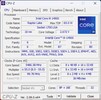Intel Core i9-14900 vs Apple M3 Pro 12-Core
Intel Core i9-14900
► remove from comparison
The Intel Core i9-14900 is a high-end processor based on the Raptor Lake architecture. The base clock is 2 GHz and can reach up to 5.8 GHz under optimal conditions. Similar to the top model (Intel Core i9-14900K), the total of 32 threads are divided into 8 p- and 16 e-cores. The 8 performance cores (p-cores) also offer hyperthreading, which means that a total of 32 threads can be processed simultaneously. The non-K model is an economical processor. There is still the option of DDR4 or DDR5 memory.
Performance
Compared to the Intel Core i9-14900K, the Core i9-14900 offers the same number of physical computing units. However, due to the lower power consumption, the Intel Core i9-14900 delivers slightly less performance. The intended use is primarily for compact PCs with limited cooling options.
Graphics unit
Like the Intel Core i9-14900K, the Intel Core i9-14900 offers an integrated graphics unit. The Intel Iris Xe architecture continues to serve as the basis. In terms of performance, however, nothing has changed with the Intel UHD Graphics 770.
Power consumption
The Intel Core i9-14900 is specified with a TDP of 65 watts, which corresponds to the PL1 value. In boost mode, the processor's performance can increase to up to 219 watts (PL2). However, this requires very good cooling. Compared to the Intel Core i9-13900, the specified power consumption has not changed.
Apple M3 Pro 12-Core
► remove from comparison
The Apple M3 Pro (12 Core) is a system on a chip (SoC) from Apple for notebooks that was launched in late 2023. It integrates a new 12-core CPU with 6 performance cores with up to 4.06 GHz and 6 efficiency cores with 2.8 GHz. There is also a slimmed-down 11-core variant with a 14-core GPU.
Compared to the M2 Pro the M3 Pro has been slimmed down somewhat and swaps two performance cores for efficiency cores. This is due to the changed core configuration, as 6 cores are now used per cluster (the M2 Pro and M3 still have 4 cores per cluster). Furthermore, the memory bus has been reduced from 256 bits to 192 bits (150 GB/s vs. 200 GB/s). However, thanks to the new architecture and higher clock rates, the new M3 Pro is still slightly faster.
The M3 Pro also integrates a new graphics card with dynamic caching, mesh shading and ray tracing acceleration via hardware. In the top model, all 18 cores of the chip are used and support up to 3 displays simultaneously (internal and 2 external).
GPU and CPU can jointly access the shared memory on the package (unified memory). This is available in 18 or 36 GB variants and offers 150 GB/s maximum bandwidth (192 bit bus).
The integrated 16-core Neural Engine has also been revised and now offers 18 TOPS peak performance (compared to 15.8 TOPS in the M2 but 35 TOPS in the new A17 Pro). The video engine now also supports AV1 decoding in hardware. H.264, HEVC and ProRes (RAW) can still be decoded and encoded.
Unfortunately, the integrated WLAN only continues to support WiFi 6E (no WiFi 7), unlike the small M3 SoC thunderbolt 4 is also supported (max 40 Gbit/s).
The chip is manufactured in the current 3nm process (N3B) at TSMC and contains 37 billion transistors (-7.5% vs. Apple M2 Pro).
| Model | Intel Core i9-14900 | Apple M3 Pro 12-Core | ||||||||||||||||||||||||||||||||||||||||||||||||
| Codename | Raptor Lake | |||||||||||||||||||||||||||||||||||||||||||||||||
| Series | Intel Raptor Lake-R | Apple M3 | ||||||||||||||||||||||||||||||||||||||||||||||||
| Series: M3 |
|
| ||||||||||||||||||||||||||||||||||||||||||||||||
| Clock | 2000 - 5800 MHz | 2748 - 4056 MHz | ||||||||||||||||||||||||||||||||||||||||||||||||
| L2 Cache | 32 MB | |||||||||||||||||||||||||||||||||||||||||||||||||
| L3 Cache | 36 MB | |||||||||||||||||||||||||||||||||||||||||||||||||
| Cores / Threads | 24 / 32 8 x 5.8 GHz Intel Raptor Cove P-Core 16 x 4.3 GHz Intel Gracemont E-Core | 12 / 12 6 x 4.1 GHz Apple M3 P-Core 6 x 2.7 GHz Apple M3 E-Core | ||||||||||||||||||||||||||||||||||||||||||||||||
| TDP | 65 Watt | 27 Watt | ||||||||||||||||||||||||||||||||||||||||||||||||
| TDP Turbo PL2 | 219 Watt | |||||||||||||||||||||||||||||||||||||||||||||||||
| Technology | 10 nm | 3 nm | ||||||||||||||||||||||||||||||||||||||||||||||||
| Die Size | 257 mm2 | |||||||||||||||||||||||||||||||||||||||||||||||||
| max. Temp. | 100 °C | |||||||||||||||||||||||||||||||||||||||||||||||||
| Socket | LGA 1700 | |||||||||||||||||||||||||||||||||||||||||||||||||
| iGPU | Intel UHD Graphics 770 (300 - 1650 MHz) | Apple M3 Pro 18-Core GPU | ||||||||||||||||||||||||||||||||||||||||||||||||
| Architecture | x86 | ARM | ||||||||||||||||||||||||||||||||||||||||||||||||
| $549 U.S. | ||||||||||||||||||||||||||||||||||||||||||||||||||
| Announced | ||||||||||||||||||||||||||||||||||||||||||||||||||
| Manufacturer | www.intel.de | www.apple.com | ||||||||||||||||||||||||||||||||||||||||||||||||
| Transistors | 37000 Million | |||||||||||||||||||||||||||||||||||||||||||||||||
| Features | ARMv8 Instruction Set |
Benchmarks
Average Benchmarks Intel Core i9-14900 → 100% n=14
Average Benchmarks Apple M3 Pro 12-Core → 89% n=14
* Smaller numbers mean a higher performance
1 This benchmark is not used for the average calculation












